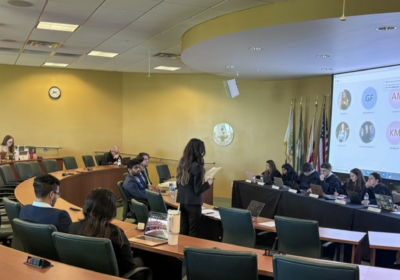Underwater robot takes to Twitter
Tweeting is not just for humans.
Tavros02, a submersible robot developed by USF researchers in the College of Marine Science, began using the Twitter name @Tavros02 on March 22 to tweet its location, water temperature and water pressure every two hours as it travels through the Gulf of Mexico. However, the robots scientific readouts could soon gain a more humanlike tone.
David Fries, director of USFs Marine Systems Technology Group and lead researcher on the project, said the team is currently working on taking Tavros02 from the ineloquence of tweets such as LAT=27.761816 LON=-82.634982 HEAD=255.50 ALT=2.60 DEP=1.06 TEM=26.44 CON=47487 #USF #SeaTweet, which Tavros02 Tweeted on Monday, into the realm of human language.
Theres a real research element to this, which is since its managing well enough on Twitter, there is actually a way to translate (to human vernacular) through a few methods, he said.
By using binary, artificial intelligence and signal processing, Fries said researchers are working on translating the boring 1s and 0s into a human language, capable of conveying the same data, or expanded data, once additional sensors are added to the robot.
The intriguing things is, were not only putting a voice to the machine or the instrument or the technology, but were putting a voice to nature too, he said. Because the sensors are detecting what is going on in the environment and it gets transformed into spoken language.
And while tweeting may be all the rage, Fries said the robots importance rests in three components: science and research, education and environmental monitoring. Fishermen could use Tavros02s tweets to determine whether conditions are met for good fishing, he said.
The fisherman concept can be interesting and even amusing, but the real more interesting thing from an environmental monitoring standpoint, and in scientific research, is lets say a manager of a lake (reads a Tweet that) says, There is a ship in the lake, the ecosystem is being affected, send out people to sample. he said. This, which we call monitoring management, has real, tangible value.
Other practical implications have already been tested. Vickie Chachere, USF News manager, said Tavros02 has already been used in research related to the Deepwater Horizon oil spill.
It was tested during some spill-related cruises last year, she said. In general, remote vehicles such as this were very helpful during the spill research. Tavros added value in its ability to stay at sea for longer because of the solar batteries.
Fries said Tavros02 has even piqued the interests of local businesses, though no inquiries have been value-seeking yet.
My sense is that first round is, Oh, this is interesting. Oh, this is novel, he said. But the more we broadcast and the more information we put out there the more we actually demonstrate richer information, beyond just the whole Twitter phenomenon thats where you really going to see the private sector looking at this as sort of a value stream.
Tavros02 is 4 feet by 8 feet long, weighs about 400 pounds and is valued at $100,000. It can go up to 500 meters deep in the water, though Fries said it has yet to be tested at those depths. The robot is the first of its kind in terms of sending continuous data from the environment to sensors in the robot to the electronic devices of the general public.
But its gender is still a matter of debate.
(Weve had a couple people) calling it a he, and its kind of stuck, Fries said. I personally you know, a guy Id like to look at it through my rose-colored glasses as a she.






